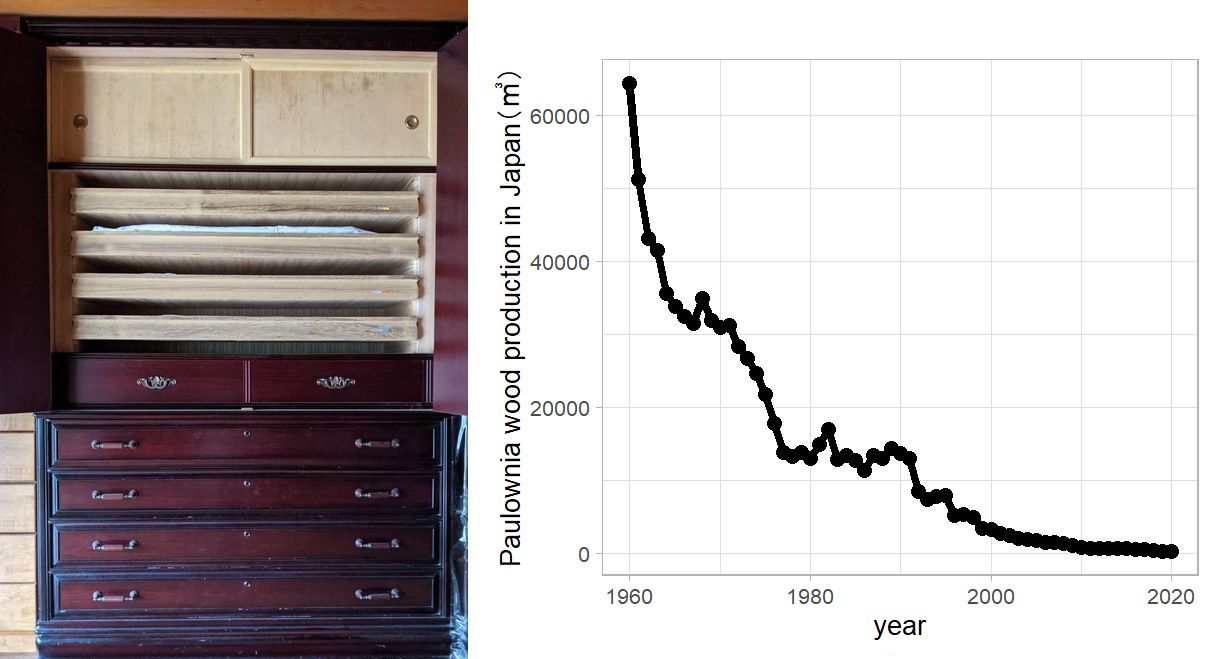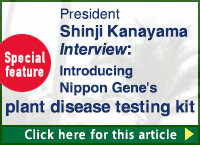Impact of phytoplasma on our lives
Impact of phytoplasma on our lives

Phytoplasmas were first discovered in Japan and are now widely known as an etiology of plant diseases. Interestingly, the historical rise of industry is deeply involved in the background of the progress of phytoplasma research in Japan. In this article, I would like to summarize the history of the phytoplasma discovery and its influence on our society.
1. History of Phytoplasma Research
Phytoplasma infects plants through insects and causes a variety of abnormalities such as dwarf, yellowing, witches’ broom, and crowding. Although these symptoms have been known for a long time, it is only in recent decades that the cause of these symptoms has been identified as phytoplasma. The term “Phytoplasma” maybe unfamiliar to people, but it is known to infect so many plants and cause problems. So where is the problem with phytoplasma?
Before we take a closer look at phytoplasma, I would like to look back a little from the history of its discovery.
1-1. Silk and Phytoplasma
The beautiful silk kimono is one of the most important cultural assets of Japan. Silk has been valued in various countries since ancient times, and it was also important as a trade goods as a name of Silk Road suggests. In Japan, from the end of Edo to the Meiji Period, sericulture was encouraged in many places, and efforts were made to produce high quality raw silk in their own countries. As a result, raw silk became an important export item in those days. Mechanization also advanced during this period, and the Tomioka Silk Mill (Tomioka City, Gunma Prefecture), which is registered as a World Heritage Site as a building of historical importance, was built in 1872.

FIG. 1 : Example of a kimono
1-2. Scientific progress in the micro-level
This discovery of phytoplasma was made by Dr. Yoji Doi of the University of Tokyo in 1967. At first, it was named mycoplasma-like organism (MLO) because its appearance under an electron microscope resembled that of mycoplasma, which causes pneumonia in humans and animals. Later, however, as biology made remarkable progress and the field of molecular biology developed, it became possible to decode DNA, the blueprint of living organisms. In the same way that you may have heard of the Human Genome Project, the genome information of this mycoplasma-like microorganism has been deciphered by Professor Shigeto Namba and his group at the University of Tokyo, and classification based on the genome information has become possible.
As a result, it was found that although the new-found microorganism was named “mycoplasma-like” because of its appearance, the organism had actually a separate lineage, and in 1994, it was renamed as “phytoplasmas”.
Therefore, phytoplasma is a phytopathogenic microorganism whose details have only become known with recent advances in science and technology.
2. Characteristics and symptom expression of Phytoplasma
Phytoplasmas were not studied well until recently because they were smaller than common microorganisms, such as Escherichia coli and other plant pathogenic bacteria known at the time, and also because they were difficult to culture.
The former was solved by the invention of the electron microscope and the careful observation of researchers using the electron microscope. However, the inability to culture made it difficult to study phytoplasma after their discovery.
Normally, in microbial research, only the target microorganism is sufficiently grown under nutrient-rich conditions (culture medium) before various experiments are conducted. If it cannot be cultured, it will be difficult to secure sufficient quantities of experiment sample to proceed with the research.
The reason why it is difficult to cultivate Phytoplasma is that Phytoplasma is a microorganism that has evolved with a slightly different survival strategy. That is to say, it is a microorganism that has left behind only the genes specialized for living as a parasite on a host, and has omitted many of the genes that are normally required for survival on their own.
2-1. Location in plants
Plants have a xylem composed of conducting vessels that carry water from the roots, and a phloem composed of sieve tubes that carry photosynthesized nutrients in the leaves. Phytoplasmas proliferate only in the sieve part of the plant, where they proliferate by absorbing necessary substances. The presence of Phytoplasma in the sieve part has various effects on the host plant. For example, infected plants are weakened and yellowing because of the nutrient deprivation by phytoplasma. To proliferate, phytoplasmas look for an opportunity to move to other plants through insects. The vector insects suck the synthesized nutrients by piercing the sieve tubes with their needles. The phytoplasma must be present in the sieve tube in order to be carried by the insect to another host. It is thought that morphological abnormalities such as crowding and witches’ broom are caused in the host for increasing the number of young tissues favored by the vector insects, thereby increasing the chance of transport by sucking.
2-2. Behavior in vector insects
In the case of humans, it is well known that mosquitoes transmit diseases by piercing the skin with their needles. On the other hand, phytoplasmas transmitted to plants are mainly
transmitted by leafhoppers (family Hemiptera), planthoppers (suborder Homoptera), etc. which have cicada-like mouthparts. Plants have cell walls that are thicker than skin, so they are insects with needles which can penetrate them.
When phytoplasma enters the insect through the needle by sucking on infected plants, it proliferates in the digestive tract, muscles, and salivary glands and spreads throughout the body of insect, eventually infecting another healthy plant through saliva when the insect sucks on it. Within the insect body, phytoplasmas are not parasitic, but symbiotic. The fact that it is transmitted by insects means that it needs to adapt within the insect and also within the plant.
2-3. Life without Energy Synthesizer?
Interestingly, because phytoplasma rely on hosts for nutritional supplies, the phytoplasma itself does not have many genes that are usually considered essential for life. It was lost by degenerative evolution. Phytoplasma has relied on the host for parasitism, and it has evolved by focusing on a mechanism for optimizing parasitism. So it is also called a “lazy” bacterium. This is why it is difficult to cultivate phytoplasma alone.
3. Phytoplasma Disease and Its Relation to Our Lives
So, how is Phytoplasma involved in our surroundings? Phytoplasma infects various plants (said to be more than 1,000 species) and is said to cause symptoms such as dwarf, yellowing, crowding, witches’ broom, phyllody, and greening. We would like to introduce some other cases of phytoplasmas that have caused significant damage, such as mulberry dwarf disease in the sericulture industry described above.
3-1. Sweet potato witches’ broom
Phytoplasma once caused devastating damage to sweet potatoes in Okinawa during the period of food shortages after the end of the war. The disease spread throughout the Okinawa Islands, and sweet potato farmers were forced to switch to sugarcane cultivation.
3-2. Kiri witches’ broom
Kiri (paulownia wood) is characterized by its light weight, low expansion and contraction due to moisture and drying, and low thermal conductivity (low flammability). Kiri wood is used as a high-grade wood material for chests of drawers and musical instruments. Domestic production has declined significantly since its peak. This is partly because the demand for paulownia wood is smaller than in the past, but also because imported paulownia wood has increased and producers have been troubled by the Kiri- witches’ broom. It takes many years for a tree to grow, but if it becomes diseased, its value as a product is lost.

Fig. 2: Decline in Domestic Production of Paulownia dresser and Paulownia Wood (Source: Ministry of Agriculture, Forestry and Fisheries; Statistical Survey on Production of Special Forest Products (2020)
3-3. Coconut blight
The Bogia coconut syndrome (BCS) has been spreading in Papua New Guinea as mentioned inThe Struggle of a Plant Pathologist in Papua New Guinea. Bogia coconut syndrome (BCS) spread and the coconut tree suffered significant damage. The fruit of coconut tree is famous as coconut, but the water content of coconut is familiar as a beverage. Endosperm is rich in lipid and can be squeezed to yield coconut oil, which is an important source of income for local residents. In developing countries, a single plant is sometimes cultivated on a large scale, as in plantations. Under such conditions there is a lack of diversity, so once a disease occurs, it spreads at once.

Fig. 3: A coconut palm standing dead.
In addition to these examples, phytoplasma is said to infect more than 1000 species of plants. Recently, there have been cases of phytoplasma-induced chlorosis in tomatoes in Japan, and sugar cane in Southeast Asia and apple trees in Europe have also been affected.
4. At the end
Throughout history, there have been incidents in which plant diseases have had a major impact on humanity, such as the potato famine in Ireland and coffee rust on the island of Ceylon. At the time, there was nothing we could do about it, but since the development of technology that allows us to understand the microscopic world, the causes of these diseases have been revealed one after another through the tireless efforts of researchers.
Today, we are surrounded by a wide variety of plant-derived products, including food and wood products. We are now living in an age where raw materials from one country are distributed throughout the world, as is known as the global supply chain. Therefore, if a large-scale plant disease occurs in a specific region, it may affect all countries.
Identifying the cause of a plant disease is the first step in dealing with it. To help identifying the disease, we hope that our easy-to-use test kit will lead to early detection and early countermeasures. We also believe that supporting such measures against plant diseases is an important part of the SDGs.
We hope that through Phytoplasma, you will become a little more interested in the plant diseases that are happening around you.
Please refer to the following for related information about the product
・-LAMP Dry Premix – Phytoplasma Universal Detection Kit
・-LAMP Dry Premix – Special offer of Phytoplasma Universal Detection Kit Trial Packaging
・The Story of Dry Reagent – The secret behind development of Nippon Gene Material’s dry reagents
References
1. Creative Destructor: Phytoplasma / Namba Shigeto / The University of Tokyo Press
2. AgriBio Nov. 2019 vol.3 No.12 / Hokuryukan
3. Mycoplosma- or PLT group-like microorganisms found in the phloem elements of plants infected with Mulberry dwarf, Potato witches’ broom, Aster yellows, or Paulownia witches’ broom. / Yoji Doi et al.
4. Ministry of Agriculture, Forestry and Fisheries Web site; Sericulture
https://www.maff.go.jp/j/seisan/tokusan/sannshi.html
5. Ministry of Agriculture, Forestry and Fisheries Web site; Statistical Survey on Production of Forest Products for Special Use
https://www.maff.go.jp/j/tokei/kouhyou/tokuyo_rinsan/
6. Forestry Agency Web Site; Production Trend of Forest Products for Special Use
https://www.rinya.maff.go.jp/j/tokuyou/tokusan/index.html




